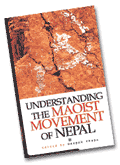Despite what Comrades Badal and Mahara have been saying at public fora in Kathmandu after coming above ground, the Maobadis seem desperate to rescue the talks. This for no other reason than the impatience of their field cadre. Once the rains are over, the leaders better have something concrete to show for their efforts.
Surya Bahadur Thapa knows this well, so he is prolonging the preparations for talks to suit his own political convenience. The mediators and human rights activists who met the Prachanda-Baburam duo recently in the New Delhi suburb of Noida recently know that Thapa knows, so even they will not be insisting too much on any preconditions for resumption of negotiations.
Once the third round of talks begin, government negotiators are likely to discover that their Maoist counterparts have suddenly developed extraordinary sensitivity for the sovereignty and territorial integrity of the country. Alas, it's already too late to do much about it. If Robert Kaplan's piece in the current issue of Atlantic Monthly (see also "Stealthy superpower" ) is true, the Americans are already here.
It appears that the Maoist fears of Pax Americana were not as far fetched as Comrade Prachanda had made them sound in his bombastic press releases. In an interview (http://www.theatlantic.com/unbound/interviews/int2003-06-18.htm) Kaplan brackets Nepal with Colombia and the Philippines as examples for 'the future of US intervention in world affairs'. Apparently, we aren't going to be an Afghanistan, if that is any consolation. But then 'US intervention' is no more just a threat, it's a hard reality of hyperpower geo-politics. The safe houses of Siliguri will never be the same again. Condy Rice just needs to turn on the burner in Washington, and it will get uncomfortably hot for Maobadi commissars in New Delhi.
It's not for nothing that Mahara & Co are exhausting curses on the Americans while remaining unusually quiet about Indian 'expansionists'. CCOMPOSA may urge the world to look at the Himalaya, as they just did after the RIM meet in Chattisgarh last week, but Maobadis know that after 9/11, South Asia will never be the same again.
For the government, the discomfiture of Maobadi leaders is a unique opportunity to lure the insurgents back into the mainstream. Instead of the usual brinkmanship of royal nominees, Thapa now needs to show vision and statesmanship. If handled properly, we might even see Maoist militia recruits heading for 'stabilisation' duty in Iraq! The necessity of 'moral ambiguity' is an essential component of Kaplan's maxim of 'Supremacy by Stealth'.
If we are confused today about Maoist motives, that is much truer of the past seven years. It is still a mystery how a ragtag bunch of frustrated politicians and social misfits succeeded in igniting a wildfire insurgency in such a short time. The importance of understanding the Maoist movement in Nepal will only grow as the world grapples with the ever-present threat of guerrilla warfare everywhere. The best way, perhaps the only way, to fight these guerrilla organisations is not to let them form in the first place.
Kaplan may not readily admit it, but there is more to the 'root cause' theory than mere post-facto justification of violence. Desperados are born when grievances-real or imagined-are allowed to fester. Once that happens, there is never any dearth of ambitious leaders ready to pounce upon the opportunity of an alluring shortcut to political success.
In editing the compendium Understanding the Maoist Movement of Nepal, Deepak Thapa has opted for variety over authority. A comprehensive introduction and five chapters cover the entire gamut of Maoist phenomenon in Nepal. But such a comprehensive treatment does have its pitfalls. There is an out and out trashy piece about Comrade Prachanda's drinking habits (two big glasses of fresh frothy buffalo milk straight from the udder at the crack of dawn) by journalist SNM Abdi alongside a scholarly paper on the anthropology of the Kham Magar country by Anna de Sales.
Though they are grouped under different chapters, as a reader it's very difficult to see the connection. Maoists have been adroit media managers, and they get into the press often and usually in their own terms. But that doesn't justify the absence of official views in this book. Two overt propaganda pieces by Li Onesto take up nearly 60 pages, but the Royal Nepali Army doesn't even get a hearing on Dunai or Holeri. In fact this anomaly is an indication of the trend where 'objectivity' of journalism often translates into ambivalence towards atrocities of the insurgents on the one hand and compulsions of the government to be ruthless on the other.
It is not just the state, even civil society chose to ignore the dire predictions of a brewing insurgency by R Andrew Nickson and Stephen L Miksell. But then, did Maoist insurgency begin as a conspiracy to undermine the legitimacy of democratic regimes? This volume has nothing to offer on Koirala's 'Grand Design' theory.
Even though this book is a collection of previously published material, it succeeds in broadening a reader's understanding of the Maoist phenomenon in Nepal. (A brutal insurgency can hardly be called a 'movement', as the title of the book suggests.) Kaplan must get a copy, if he doesn't have one already.

Understanding the Maoist Movement of Nepal
Deepak Thapa (ed)
Martin Chautari, Kathmandu
pp (xx)+395
Rs 475


